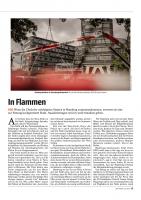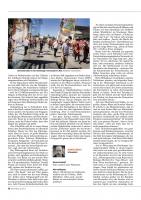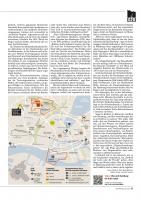When the leaders of the world's most powerful economies descend on Hamburg next month, the city will be a virtual fortress with the deployment of 20,000 police. Officials believe violent protests are likely.
The arrival of kilometers of razor wire served as a harbinger of things to come.
The
wire was delivered in order to protect police headquarters in the
northern part of Hamburg. Police are affixing it to fences around the
site in the city's Alsterdorf neighborhood, and razor wire also now
circles a former grocery wholesaler warehouse in the city's Harburg
district, which is being converted into a "central holding place" for
arrested protesters. It will have work spaces for prosecutors and judges
and rooms for defense lawyer consultations and cells for 400 detainees.
Workers
began unspooling the razor wire on March 28. It is aimed at preventing
incidents like the one that happened two nights earlier. At 2:42 a.m.,
local residents heard a bang at a local police station in Hamburg's
Eimbsbüttel neighborhood. A short time later, a fleet of police cars
inside the parking lot was in flames. The perpetrators had brought along
a ladder to scale the three-meter wall (about 10 feet) and they
completely burned out four police vehicles and left four others badly
damaged. A group calling itself Smash G-20 claimed responsibility for
the crime. As the protectors of the "existing order," the police had to
be attacked with "full force," the group wrote on an internet portal
used by the leftist-autonomist scene.
And on Monday of this week,
anti-G-20 activists claimed responsibility on the internet for arson
attacks that disrupted railway travel all across Germany. The German
government says 13 different cables carrying signals and other data were
burned, causing numerous train cancellations and delays.
Before the police can provide protection for the G-20 summit and for the city on July 7-8, they first have to be able to protect themselves -- hence the razor wire. The city is expected to be in something close to a state of emergency when the leaders of the world's leading economies converge on the northern German port.
They will arrive in a
well-prepared metropolis, with an exclusion zone and 20,000 police
officers deployed from all across Germany. Mounted police will be
present, as will canine units, snipers and special forces. The German
federal police's elite GSG 9 counterterrorism unit will also be on-site.
Officials are expecting up to 100,000 protesters, including militant
groups seeking to disrupt or, if they can, prevent the summit.
Hamburg
is fond of calling itself the gateway to the world, but now it faces
the problem of the world's leaders all descending on the city at once.
The result being that the world famous and cosmopolitan port city
suddenly finds itself being rather fearful of the world.
Risks for Hamburg's Image
Much
is at stake for Hamburg. If everything goes according to plan, positive
images will be broadcast across the world of leaders visiting the
city's spectacular new philharmonic concert hall. But there could also
be images that are disastrous for the city's image, as experienced in
Genoa during the G-8 summit there in 2001. That year, anti-globalization
activists clashed with police in street battles, barricades were
burned, hundreds of people were injured and one demonstrator was shot
and killed by police. It's a risk Hamburg also now faces.
The
city's senator for domestic affairs, Andy Grote of the center-left
Social Democratic Party (SPD), who is Hamburg's top security official,
is aware that only a certain amount of control is possible. "Others are
responsible for any violence that is imported to this city," he says.
But, as any interior minister would do, he says he is certain that
Hamburg police are up to the challenge.
The day before
the summit, up to 80 government aircraft will be landing at the city's
Helmut Schmidt Airport, including jumbo jets like U.S. President Donald
Trump's Air Force One. A few aircraft will just be dropping people off
before taking off again and parking at other nearby airports. The air
strips at the Hamburg Airbus factory as well as Lufthansa Technik in the
area will also be used for parking the world leaders' aircraft.
In
the days preceding those arrivals, cargo jets will be flying in from
all over the world carrying the equipment required by the various
delegations. In addition to the president's motorcade, the U.S. even
flies in its own jet fuel because U.S. military aircraft use a different
kind of fuel than that which is available at the Hamburg airport. It
has even been reported that one sheikh will be bringing his own
escalator so that he can board and disembark his aircraft more
comfortably.
Delegations from all 20 countries will be coming to
Hamburg, as will representatives from other non-G-20 countries like
Spain and Singapore. The U.S. president alone will have 600 people
traveling in his delegation, including staff and security. When they are
driven around the city, the police will have to hope that everything
goes according to plan and as they have practiced it.
Officials
in the city plan to maintain an overview of the situation from a control
room behind the razor wire in Alsterdorf. Room 210 will be staffed by
around 50 people and 16 large monitors will be in the room, with
horseshoe-shaped desks in front of it. With all the telephones,
monitors, computers and radio units, there's a Cape Canaveral feeling to
the room. "Except we're not planning on launching any rockets here,"
says one person present.
The command here will have access to
traffic and CCTV cameras in the city, to site plans and also to
intelligence reports. Officers operating water cannons and mounted
police will be given their directions from the command center. And when
U.S. President Donald Trump's motorcade drives through the city, the
streets will have to be empty.
The doors of his Cadillac,
nicknamed "The Beast," are equipped with titanium armor and are as heavy
as those of a Boeing 757 jet. The car even has its own oxygen system
that can protect the president against a chemical weapons attack. The
car has 8 tons of security technology and it cannot be allowed to come
to any unplanned stops. Interior Senator Grote has already warned
protesters against seeking to try and block Trump's motorcade, saying
nobody knows how the American Secret Service might react.
A total
of 42 participants at the summit will have the same high-level security
classification as Trump, including Russian President Vladimir Putin,
his Turkish counterpart Recep Tayyip Erdogan and summit host Angela
Merkel. Even without any protesters who might try to get in the way of
these state visitors, the presence of all these leaders would still
present a major logistical challenge. But there will be protesters -
thousands if not tens of thousands.
Protesters To Converge from All Across Europe
Anti-globalists
from all over Europe are traveling to Hamburg for the demonstrations -
both peaceful activists and militant ones. Some have been as detail
oriented in their preparations for the summit as the Hamburg
authorities. The police have been practicing operations involving
guiding the convoys of world leaders to their destination, with police
motorcycles in the front and police cars in the back. But opponents of
the G-20 have also been practicing ways to disrupt those motorcades.
On
a sunny Thursday afternoon in May, a handful of men and women could be
seen at a playing field in the Walddörfer neighborhood in northeast
Hamburg in front of a banner reading "Global Justice Instead of the
G-20." With their arms linked together, they shouted, "Break the power
of the banks and corporations!" Two men then picked up a protester and
carried him several feet away. "Get lost! Get lost!" the others shouted
at the pair.
The scene was merely a dry run for what would take
place in July, and neither protesters nor the police were real. The
network Attac, a group critical of globalization, had organized a
four-day long "academy" for 150 activists. They painted protest signs,
practiced drumming and studied battle cries. The sit-in protest they did
was just a simulation of the simulation -- improvised for the media who
needed images for their coverage but weren't allowed to attend the real
training for the sensitive aspects of the protests.
During lunch
at the event, some participants spontaneously decided to hold a protest
in Hamburg's city center on the next Saturday in order to show and
apply what they had learned here: dressing up as clowns, chanting and
giving persuasive speeches. Alas, it was a holiday and, with the police
and city offices closed, they were unable to reach anyone to register
their protest.
Niklas, 22, a slim young man with blond hair, is
sitting on a wooden bench. He says he works in the media industry and
that this is the third time he has been to a protest academy class. He
says he's fascinated by the G-20 protests because "a large swath of the
mainstream middle class and radical leftist groups are working
together." He hopes with "all his heart," he says, that the protests
will remain peaceful. "But I also know that we can't guarantee that."
Police
in Hamburg aren't overly worried about the fact so many
anti-globalization protesters will be converging on the city. Their
greater concern is the number of summit opponents who aren't afraid of
using violence. And that number could be higher than what had been
predicted a few months ago.
Up To 8,000 Leftist Extremists Expected
On
March 10, the Hamburg State Office of Criminal Investigation (LKA)
issued a situation report predicting a turnout of around 4,000 left-wing
extremists who could potentially resort to violence. That's the number
that participated in the December 2013 pro-refugee demonstrations in the
city that devolved into riots. The report stated that at least that
many extremists and the same level of militancy should be expected in
July. But the G-20 summit has far deeper meaning for the autonomous
scene than the December 2013 melees. The autonomous protest scene, which
has a strong network across Europe, views the summit as a unique
opportunity to restore their reputation within their political spectrum.
Officials at the LKA believe the radical anti-globalists will converge
on summit sites from all directions in multiple prongs. If one prong
fails to get through, the protesters hope another will be able to
surmount the barriers.
Research conducted by Germany's Federal
Office of Criminal Investigation (BKA) detected activists in the
Netherlands, the United Kingdom, Switzerland and Italy preparing to
travel to the G-20 summit. Others protest groups are expected from
Austria and Greece. Hamburg's Domestic Affairs Office, responsible for
security in the city, made an upward revision to its figures a little
over a week ago and is now estimating 7,000 to 8,000 potentially violent
protesters. Estimates from the German federal government are even
slightly higher.
Another factor that is worrying security
authorities is the number of Kurdish supporters of the Kurdistan
Worker's Party (PKK) -- which has been banned by the European Union as a
terrorist organization -- that will turn up to protest against Erdogan.
Just as the left-wing autonomous scene has done, the Kurds, who have a
significant population in Germany, have been organizing across the
country for the summit. And even here, the boundaries between the
leftists and the Kurds are often blurred. How many Kurds will be
traveling to Hamburg -- 5,000 or 10,000? And will there be clashes with
Turkish supporters of Erdogan?
"Instead of making optimistic
predictions," the SPD-led government in the city-state should be
"speaking openly about the risks created by the militant opponents of
the summit and the threat potential for the city," says Dennis
Gladiator, the domestic affairs spokesman for conservative Christian
Democratic Union (CDU) in Hamburg. He argues the summit will be a test
for the rule of law. If a democratic country can't guarantee security at
a summit like this, Domestic Affairs Senator Andy Grote has warned,
then it could well serve as affirmation for totalitarian regimes, who
might then argue that democracies are inept.
A week ago Monday,
police began patrolling Germany's external borders -- an enormous task.
"Where possible, we want to try to identify and stop violent
troublemakers at the point they try to enter the country," says Dieter
Romann, the head of Germany's Federal Police.
Hamburg a 'Hotbed of Activists'
At
the moment, police officials and staff at Germany's domestic
intelligence agency are focusing their attention on two sites in Hamburg
where summit opponents may be meeting and organizing: an alternative
political and cultural center called Rote Flora, a building in the
city's Schanzenviertel district occupied by squatters, and the
Gängeviertel, a neighborhood in the city center located directly along
the streets leading to the Congress Center where the main G-20 events
are to be held. The streets are also home to several hotels. "If there's
an unfavorable place to hold the summit, then it's Hamburg, which is a
hotbed of leftist autonomist activists," says one high-ranking security
official. And one of the worst places you could hold your main events is
at the Congress Center, because of its immediate proximity to the Rote
Flora and its location right next to a major train line whose tracks are
laid on "millions of rocks" that could be used as weapons by
protesters.
But police sources say that the "threshold for
intervention" will be very low. Noting the possible deployment of water
cannons, one official offered: "We love water games."
If the plan
developed by local security authorities works, then the protests will
be barely noticeable to the people of Hamburg. Mayor Olaf Scholz of the
SPD and Falko Drossmann, the head of the district office for the city
center, have said that they have tried to keep the limits being applied
to the city center to a minimum.
But that does not apply to those
who live and work within the security zone. Some companies located in
the city center will have to close for three days. Part of one major
shopping center in the city is located inside Security Zone 2 and people
will have to show their ID in order to enter. The other side of the
same shopping center is located in Security Zone 1, and all access is
prohibited.
The effects of the G-20 summit can even be felt some
30 kilometers (about 19 miles) north of Hamburg in the small town of
Kisdorf. Each year, the town holds a kite festival on the meadows of the
Jakobs family farm. Each year, there are foam parties for the children,
unicyclists, belly dancers and kite-flyers from all over Germany. About
140 hobbyists had planned to fly their fantasy creations. But the
Economics Ministry for the state of Schleswig-Holstein, which surrounds
Hamburg, rejected the permit request this year. The reason given:
Government-issued flight restrictions in the area from July 6-9 apply to
all flights "including the operation of model airplanes and unmanned
aviation systems."
Local residents are planning on moving ahead
with what they are describing as a "Festival of Love and Happiness," but
they are holding the event a week earlier now. Whatever happens at the
G-20 in Hamburg, however, it is unlikely to be as peaceful or happy.



